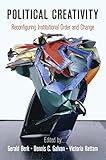Political Creativity : Reconfiguring Institutional Order and Change / ed. by Gerald Berk, Victoria Hattam, Dennis C. Galvan.
Material type: TextPublisher: Philadelphia : University of Pennsylvania Press, [2013]Copyright date: ©2014Description: 1 online resource (368 p.) : 1 illusContent type:
TextPublisher: Philadelphia : University of Pennsylvania Press, [2013]Copyright date: ©2014Description: 1 online resource (368 p.) : 1 illusContent type: - 9780812245448
- 9780812209204
- 320.01/9 23
- JA76
- online - DeGruyter
- Issued also in print.
| Item type | Current library | Call number | URL | Status | Notes | Barcode | |
|---|---|---|---|---|---|---|---|
 eBook
eBook
|
Biblioteca "Angelicum" Pont. Univ. S.Tommaso d'Aquino Nuvola online | online - DeGruyter (Browse shelf(Opens below)) | Online access | Not for loan (Accesso limitato) | Accesso per gli utenti autorizzati / Access for authorized users | (dgr)9780812209204 |
Frontmatter -- Contents -- Introduction: Beyond Dualist Social Science -- PART I. Relationality -- Chapter 1. Processes of Creative Syncretism -- Chapter 2. Ecological Explanation -- Chapter 3. Governance Architectures for Learning and Self-Recomposition in Chinese Industrial Upgrading -- Chapter 4. Reconfiguring Industry Structure -- PART II. Assemblage -- Chapter 5. Animating Institutional Skeletons -- Chapter 6. Creating Political Strategy, Controlling Political Work -- Chapter 7. Accidental Hegemony -- Chapter 8. The Fluidity of Labor Politics in Postcommunist Transitions -- PART III. Time -- Chapter 9. From Birmingham to Baghdad -- Chapter 10. The Trouble with Amnesia -- Chapter 11. Interest in the Absence of Articulation -- Conclusion. An Invitation to Political Creativity -- Notes -- Contributors -- Index -- Acknowledgments
restricted access online access with authorization star
http://purl.org/coar/access_right/c_16ec
Political Creativity intervenes in the lively debate currently underway in the social sciences on institutional change. Editors Gerald Berk, Dennis C. Galvan, and Victoria Hattam, along with the contributors to the volume, show how institutions inevitably combine order and change, because formal rules and roles are always available for reconfiguration. Creative action is not the exception but the very process through which all political formations are built, promulgated and changed.Drawing on the rich cache of antidualist theoretical traditions, from poststructuralism and ecological theory to constructivism and pragmatism, a diverse group of scholars probes acts of social innovation in many locations: land boards in Botswana, Russian labor relations, international statistics, global supply chains, Islamic economics in Algeria, Islamic sects and state authority in Senegal, and civil rights reform, colonization, industrial policy, and political consulting in the United States. These political scientists reconceptualize agency as a relational process that continually reorders the nature and meaning of people and things, order as an assemblage that necessitates creative tinkering and interpretation, and change as the unruly politics of time that confounds the conventional ordering of past, present, and future. Political Creativity offers analytical tools for reimagining order and change as entangled processes.Contributors: Stephen Amberg, Chris Ansell, Gerald Berk, Kevin Bruyneel, Dennis C. Galvan, Deborah Harrold, Victoria Hattam, Yoshiko M. Herrera, Gary Herrigel, Joseph Lowndes, Ato Kwamena Onoma, Adam Sheingate, Rudra Sil, Ulrich Voskamp, Volker Wittke.
Issued also in print.
Mode of access: Internet via World Wide Web.
In English.
Description based on online resource; title from PDF title page (publisher's Web site, viewed 30. Aug 2021)


